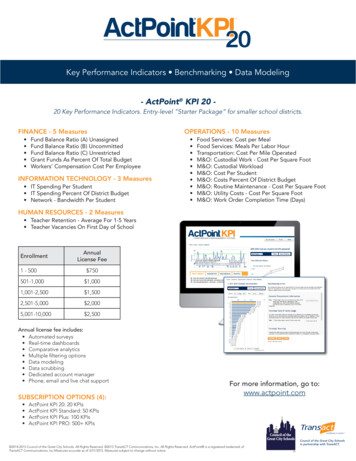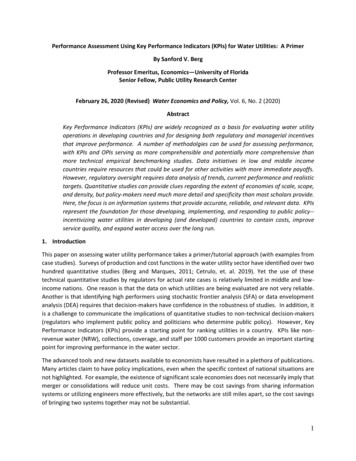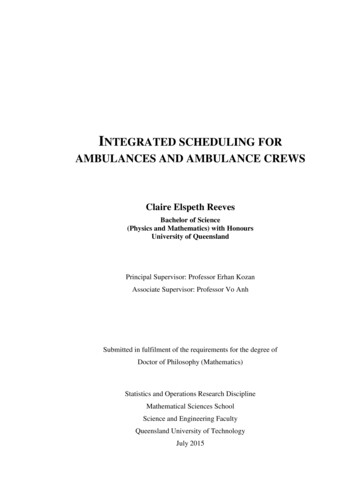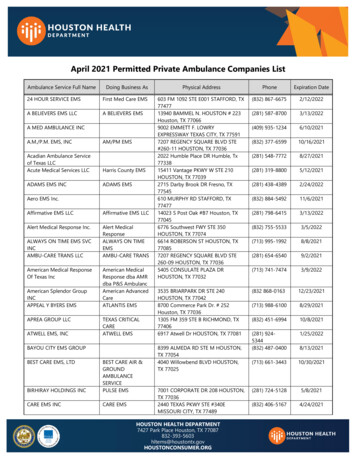
Transcription
Implementing KPIs in yourAmbulance Billing DepartmentBy Donna MagnusonWhitepaper
Implementing KPIs in your AmbulanceBilling DepartmentKey Performance Indicators (KPIs) are quantifiable measurements that a company uses to evaluateorganization performance and efficiency. They are measurable, objective, and actionable. KPIs arepowerful because they tell you what to improve within your processes. Measuring can positivelyimpact billing processes and productivity. Additionally, KPIs initiate triggers for change in areas thatan agency may not realize require re-evaluation. This document will offer recommendations for KPIsto implement within an Ambulance Billing Department. During the implementation of the KPIs you willdevelop tools to determine your own KPIs and make positive impact to the billing department.One of the challenges to implementing KPIs is determining where to start and knowing which specificKPI measurements fit best within the billing department. If you don’t know where to start, the bestrecommendation is to just start measuring. The details and the specific KPI measurements will beginto fit into place once you gain more knowledge.Front-end, meaning prior to claim transmission, and back-end, defined as post claim transmission,measurements will be addressed within the article. As author, I have taken the liberty to include someindustry metrics that I feel are relative during the course of my 20 year career in medical billing. Theyare provided below in some of the examples. However, once initiating the measurement process forKPIs, I feel confident you will gain information to modify the KPI ranges specific to your organization.Front-End MeasurementsKPI’s for front-end processes are: Billing Lag Trip Volume Pre-biller and Coder Productivity Payor MixBilling LagBilling Lag measures the average number of days it takes to bill a claim. This measurement takes intoconsideration the department’s effectiveness in reconciling dispatched trips, tracking and resolvingproblem trips, staff productivity, and process efficiency. I often find reconciliation of unbilled and problem trips are not managed well within an organization resulting in lost revenue. The billing departmentmay be two days behind in processing run-reports but the system may show a much larger number. Alarger organization, with numerous stations, and not utilizing an electronic patient care record (ePCR)system, may take 1-2 days to actually receive the paper charts extending the lag time to 3-4 days.Regardless, establish a baseline that allows for the timeliest billing. The two key criteria needed are theaverage numbers of “billable trips per day” and the “total number of trips to be billed”.1
The following calculation assumes that Dispatch and Billing are either integrated or an interface existsbetween them. The reports listed in the document are found in the Professional Reporting package ofRescueNet Reporting. If you don’t have the Professional Reporting package, contact your local ZOLLsales representative.Data and Calculation1. Determine the total number of trips to be billed. In ZOLL RescueNet Billing, the data includes trips at a “complete” status from the date of billing go-live date to current. The report,Reports Billing Trends Trip Count/Amount by Schedule/Event can be used. Don’t filter bydate and only select the status of Complete.2. Determine the average number of transports per day. Run a report that shows the totalnumber of billable transports for the previous full month. The report, Reports General Triprelated Counts Trip Count of Call Type by Month or Trip Count by Date/Call Type can beused. Be sure to include the billing statuses of; billed, closed, complete, and verified and onlyinclude the previous full month. Divide the total number of transports into the number of working days for the month.3. Divide the average number of transports per day into the total number of outstanding trips tobe billed.EXAMPLECalculating the average transports per dayBillable transports for Nov 2012 6,500Working days* Nov 2012 22Average (Avg) transports per day 6,500 / 22 295*Working days are recommended instead of calendar because the billing staffhas to fit 7 days of transports into a 5-day work week.Calculating the billing lagTotal number of transports to bill 2,280Previous months Avg transports per day 22Billing Lag 11,280/22 7.7KPI for Billing Lag 1 to 2 daysAnalyzing Your Data:If the billing lag is greater than 1-2 days, determine the reason. Are the trips not billed due to staffingor productivity? Is there a lack of reconciliation processes leaving a large amount of unaccounted fortrips? Is there a large amount of missing information which holds up the billing for several days? Itcould be logistical that it takes 3-4 days for the patient care reports to be received. However,determining the reason will improve process in billing and operations. Comparing the average dailytrip volume (based on a 5-day work week) against the pre-billing and coding productivity will help to2
determine if a lag is due to staffing. If the daily average volume is more than the total productivityexpectation for either group, overtime or additional staff needs to be considered.Keeping the lag to 1 to 2 days allows the billing office to quickly determine what may be missingand for operations to quickly respond. If a trip is found to be missing a run report 8 days after thetransport, the likelihood of getting or recreating a report is less viable. Not meeting the signaturerequirements at the time of transport requires additional effort and increases the timeliness of billing.Trip Volume and StaffingUsing the trip volumes provides an objective approach to identifyingthe amount of billing staff required. Ongoing measurement of thetrip volumes will provide a trigger when staffing needs to bemodified. Additionally, reviewing the volumes by the “type” of call;i.e. wheelchair, emergency, etc. can determine the level of effortneeded in the billing department. Use the KPIs given below as aguideline. Billing systems, processes and structures are differentand the recommended staffing ratios may need to be adjusted.Data and Calculation1. Determine the total number of transports per month by the type of transport, i.e. wheelchair,BLS, etc. Run the report, Reports General Trip related Counts Trip Count of Call Type byMonth report for a rolling 12 months (a year from the most previous full month). Be sure toinclude the billing statuses of; billed, closed, complete, and verified.2. Divide the recommended staffing ratio into the total number of transports per year for thatparticular call type to get the total number of staff.KPI – Recommended Staffing RatioType of TransportTransports/FTE*/YearLower Range Upper mergency4,0005,000*Full Time Equivalent (FTE)**The staffing recommendations above do not include management. To account for management staff,take the total number of transports per year and multiply by 10%.3
EXAMPLEABC Ambulance Company - Transports by call type and trip monthTransport TypeDec-11Jan-12Feb-12 v-12TotalBLS Non-Emerg 4,3894,40137,701ALS - g Recommendation for Basic Life Support (BLS) Non-emergency transports37,701 total transports/ 5,000 transports/FTE 7.5 FTEStaffing Recommendation for Advanced Life Support (ALS) Emergency transports10,621 total transports / 5,500 transports/FTE 2.0 FTEStaffing Recommendations for Wheelchair transports6,616 total transports / 12,000 transports/FTE .5 FTETotal billing staff recommendation – 10 FTEPlease note, using the lower-end range vs. the upper-end range is dependent upon a multitude of criteria but is ultimately affected by the quality and completeness of information received into the billingdepartment, automations, and efficiency in the billing department.Analyzing your Data:Review the trips volumes daily and monthly. Knowing the average daily and monthly trip volumeswill help to keep the billing department staffed appropriately. If future growth is forecasted, use thesenew projections with the Billing Staff Ratios to prepare accordingly. Implementing productivity guidelines within the department will aide in determining the staffing for each function; pre-billing, billing,follow-up, etc. This will be explained further in the next section.Pre-biller and Coder ProductivityThere are numerous benefits to establishing benchmarks for both the pre-billing and coding staff’sproductivity. These include: Consistent billing consistent cash flow Efficient staffing Daily and/or weekly feedback provided to the staffProductivity is typically higher when consistently measured. Use the KPI recommendations below as aguideline to start the process, however it is recommended that productivity be evaluated for a periodof time to establish guidelines that are meaningful for your organization. An employee meeting a4
quota is the ultimate goal. However, it can backfire if their quota becomes more important thatproducing quality results. The areas that potentially impact quality are; paper vs. electronic PatientCare Reports (ePCR), the quality and accuracy of the PCR, lack of training and feedback to EMTcrew members regarding billing requirements, if billing department consistently receives face sheetsfrom the facility or if they have system access into a facility, the tools available to the staff (i.e. eligibility,address search, etc.). The more the billing staff has to hunt for information or place a trip on holdand request information the less they will be productive and effective.Data and Calculation1. Run a system report and compare the data with the KPI below. Depending upon the billingroles you have within your organization; Pre-biller, Coder, or a Biller that performs both pre-billand coding functions determines what you need to track. Obviously these titles may be different in your organization. Consider the following ZOLL RescueNet Reporting reports: Reports Billing Collections Notes Activity Report. Select the User, note types, and note date. Reports Billing Trends Trips Verified by Biller by Day or Trips Verified by Biller by Week.Select the verified date.KPI - Pre-biller and Coder ProductivityRoleProd / DayCommentPre-Biller50-70 / Day6-9 / HourA pre-biller is typically responsible for verifying demographicand insurance information. Assuring that complete informationis receivedCoder80-120 Day10-15 / HourThe coder is typically responsible for applying the ICD-0 code,completing the billing narrative, completing the ambulancecertification requirements, verifying the level of service andmodifiers, and verifying patient signatures requirements are met.Biller30-65 / Day4-8 / HourThis role fulfills both pre-billing and coding functions. There isa lot of information this role needs to check and confirm therefore, the productivity is typically lower to allow for accuracyand thoroughnessPlease note, using the lower-end range vs. the upper-end range is dependent upon a multitude of criteriabut is ultimately affected by the quality and completeness of information received, automations, andefficiency in the billing department.You can also use this information to determine the staffing for each of the areas. Once havingcalculated the productivity KPI, you can divide this KPI into your total trip volume.See the “Calculating Staffing for each Department” example below. Remember to take into considerationvacations, holidays, sickness, etc. It is most effective to see the daily productivity report trended for themonth-to-date.5
EXAMPLECoding Productivity 085100JDoe 2826606480991226378899145JDoe 325983856914265082700105Dly Total198247131215253226278149248249176250Wkly Total1,0441,150Calculating Staffing for each DepartmentAverage Daily Trip Volume 230Productivity Expectation Pre-bill 65 / day Pre-billers needed 230/65 3.5 or 4Productivity Expectation Coding 80 / day Coders needed 230/80 2.8 or 3Analyzing Your Data:Daily Productivity – refer to productivity example above. Review the productivity trends for consistency. It is best to view the productivity trended overa period of time as in the example above. JDoe consistently meets or exceeds the coding expectation of 80 transports per day. JDoe 2 meets the expectations the majority of the time but has days where theproductivity is below. JDoe 3 is very inconsistent or is out of the office sick. Evaluate the reason for theinconsistency and determine a plan of action. Use the productivity in conjunction with the average daily trip volumes to determine if theirdaily output meets or exceeds the average daily trip volume. Staffing was calculated based onproductivity so if the team is not producing, most likely the billing lag timelines are increasing.If the average daily trip volume is 230 the staff must produce 230 or more per day. In theexample above, there is an issue. The average productivity for the 12 days in the exampleabove is 218 which mean we are not meeting the daily trip volume. Over time, the billinglag will increase. Another consideration is when to supplement your existing pool with additional staff or overtimesupport. If the staff is meeting their productivity guidelines and volume continues to increase, additional effort may be needed.Payor Mix AnalysisThe “payor mix” is the distribution of trips across the various payer classes such as; Medicare, Medicaid,Insurance, etc. The payor mix can significantly affect the revenue within an organization. Although it ismost often determined by the demographic area in which your organization provides services, front-endbilling processes can skew the outcome impacting revenue and requiring additional effort in the billingdepartment.6
Data and Calculation1. Determine the payor mix. Run the report, Reports Billing Trends Trip Count by Primary Payor Typeor the Trip Count by Primary Payor Category. Include the statuses; billing, closed, complete, andverified. I recommend reviewing the information for a rolling year from the most recent month. If itis November 12, 2012 my date range would include 11/1/2011 – 10/31/2012. This report isa current snapshot of the distribution of trips across the payer classes. Therefore, depending uponthe thoroughness and consistency of the front-end processes, the payor mix can change for previousmonths. If the report does not show percentages, download the report into Excel and add a formulato calculate percentages by dividing each monthly payor class subtotal into the monthly total.EXAMPLEPayor Mix Report ExamplePayor ClassMar-12 Apr-12 May-12 5 1,5271,4261,456 56306212268TOTAL3,9203,646 3,8783,7903,9313,7753,7133,7203,797Payor ClassMar-12 Apr-12 May-12 OTAL100%100%100%100%100%100%100%100%100%KPI – Payor MixKPI’s for payor mix are slightly different for each ambulance company. It can be dependent upon the demographic area, the type of business model, and contracts with facilities and payors. Emergency organizations may have a higher Insurance and Medicaid percentage as Contracts typically aren’t applicable.Analyzing Your Data:Payor ClassRangeMedicare40% -50%Insurance18% -23%Contracts13% -18%Medicaid9% -15%Patient3% -9%7
Refer to the Payor Mix Example above Look at the trend from one payor class to another. Items worth reviewing include; any increasein transports or variances in one payor class over another. With the recent economy challenges,many ambulance providers saw a slight shift in their payor mix from insurance to patient. Use the example above to compare Oct-12 percentages to 6 months prior, May-12 for example.Look how the percentages change. The Patient Class in Oct-12 was 30% but decreased to 19%in May-12. This is most likely due to the staff finding an insurance company to bill as a result ofpatient’s calling regarding their account or follow-up calls. There is evidence of this because theMay-12 Medicare and Insurance percentages increased approximately 6% compared to the Oct-12figures. The Patient percentage of 19%-20% is the truer percentage and is still high. Look at thefront-end processes and determine if there is opportunity for improvement. If the front-end staffdoesn’t have the tools, information, or billing processes in place to bill insurance rather than thepatient, it can delay a payment out 4-6 months. Weak front-end processes mean costly departmental and staffing costs. There is a higher costof time and money affiliated with having to initiate the billing process multiple times. If the pre-billing processes are strong, the trending of the payor mix volume can be used as atool for forecasting payments.Back-End MeasurementsKey measurements for KPI’s for back-end processes are: Accounts Receivable Analysis Follow-up Productivity DenialsAccounts Receivable AnalysisAn Accounts Receivable (AR) Summary gives an account of balances not yet collected. Normally, a reportcan be accessed by a variety of criteria including; by patient, insurance plan, and payor class or class.To use the AR Report as a billing benchmark, accessing the data by “payor class” is recommended.Running the aging by the “trip date,” the majority of the AR should be resolved before 90 days. However,if 40% or more of the AR is greater than 90 days then problems in the billing process obviously exist.Review the aging report and attempt to identify “why“ claims are getting denied or not paid.Data and Calculation1. Run an Aging by Payor Type/ by Trip Date report for all unbilled accounts receivable. ThePeriod Closing Aging report can be used.2. To calculate the percentage of AR greater than 90 days add the total dollar amount for theAR buckets greater than 90 days.3. Divide this subtotal into the total amount of AR on the books.8
EXAMPLEAging by Payor TypePayor type0-3031-6061-9091-120121-180Over 180Total Bal 90% 90Bill 446%26%Private Pay3,9201,9501,32001002,3809,6702,480Grand ,359,1772,057,084Amt 9023%18%12%8%13%26%100%47%AR 90 days – 2,057,084 / 4,359,177 47%KPI – AR greater than 90 days is 18%-25%Analyzing Your Data:Look at the report to determine whether the AR in each class is appropriate for the payment patternsfor a particular group of payors. If you find something atypical, run an Aging by Payor to look at theparticular payor class more closely. It can be typical that the outstanding AR greater than 90 days ishigher for Medicaid given how slow they pay in some states.If the percentage of AR greater than 90 days is higher than 25% and/or near 50% then there areissues within the billing department. It is difficult to diagnose unless you look closer at the processes.It could be a combination of different issues including weak front-end processes such as; Patient responsibility is assigned instead of pursuing insurance responsibilityInsurance verification is not completedPatient addresses are not verified at the very least against U.S. Postal Service recordsPre-billers and coders are significantly behindElectronic claims submission is not implemented except for Medicare. Submitting paper claimsisn’t reliable and the processing time is significantly longer than using an electronic process. Denials and unpaid claims are not worked in a timely manner. Organizations that don’t havestaff specifically assigned to follow-up generally have a high percentage of receivables greaterthan 90 days. The longer a balance sits unworked the more likely it becomes uncollectable.Many insurance companies, including Medicare, have a time limit in which the denial must beappealed otherwise the balance becomes bad debt. Patient balances are not turned over to a collection company consistently after 60-75 days.9
Follow-up/Collections ProductivityEvaluating the productivity and effectiveness in the follow-up andcollections area of billing can be challenging because there aren’tclear indicators of success. Assigning a productivity standard sets anexpectation that a certain number of claims are worked consistentlyevery day. Frequent auditing of the notes and accounts along withevaluating the AR greater than 90 days by payor class will help todetermine effectiveness.Data and Calculation1. It is best if you have a report that shows a summary as well as details to include the accountnumber to allow for auditing. Use the report, Reports Billing Collections Notes Activity Report(Detail). Evaluating the number of accounts worked by the type of note is recommended. InRescueNet Administration, create ‘note types’ for follow-up, incoming patient calls, and denials/correspondence. Every time an account is worked for an un-adjudicated balance (no paymentor denial was received from the payor) the follow-up note type should be documented within theaccount. Activities should include; performing follow-up answering incoming patient calls/correspondence researching and resolving denials2. To develop effective collections, align the follow-up staff by the payer classes. This will allowyou to look at the aging greater than 90 days to see if the percentage delinquent is within thesuggested range.3. Run a payment report by payer class to determine how the payments are trending over time.This requires a custom report or modification of a current payment report. I have seen significantincreases in the monthly payment amounts when employees are effective in the follow-up andcollection efforts. When you first start this process and the AR greater than 90 days is 40% orhigher then is clean-up that needs to be completed. The most effective way to address this issueis to create a strategy for the follow-up staff. Assign certain days or half days where new AR isworked vs. old AR or target payers where timely filing may be nearing, target high balances, etc.Additionally, you need to make sure that processes are in place so that AR needing written-off ofreviewed by a manager is completed and the balance isn’t left unresolved. There should be anaction for 95% of the denied and unpaid balances.10
Productivity 1Follow-up364248464822374738442632Cust Svc 95762Note Detail ExampleRun# / TimeCus Name / NoteTypeTrip DateScheduleEventPayorBalance1456Maynerd, MayoCus Svs1/4/2012Denial ReviewCommercialBCBS640.008:00Customer called to provide new insurance information1832Smith, KathyAcct. ReviewAetna832.008:11Called Aetna, paper claim not received. Address on payer is not correct, corrected address and refiled claimFollow-up 9/14/2012CommercialPayment by Payer Class ExamplePayer ClassJun-12Jul-12Aug-12Sep-12Oct-12Bill 188KPI – Follow-up/Collections Productivity 50-65 trips per dayAnalyzing Your Data:The KPI range will need to be adjusted for your organization depending upon the roles responsibilitiesand the level of effort needed to work the accounts. For example, if the staff is responsible for answering incoming customer service calls, this will impact the number of accounts where follow-up can becompleted. If several of the claims need to be appealed than this is time consuming and the lowerrange of 50 trips may even need to be adjusted to a lower expectation. If the staff can access adjudication status on a payor’s website and not sit on hold, the higher range of 65 trips per day might beappropriate.Auditing of the notes, payment and aging trends by payer class will help to determine an individual’seffectiveness. It is helpful to get a detailed notes report that shows the time of the phone calls, the patient names, payer, schedules, account balance, note type, and the specific note. This will is helpful toanalyze the strategy used, time management, and diligence when working the accounts. Did they workthe outstanding accounts by payer, patient, high balances, old accounts, etc? The effectiveness can beseen in the aging and payments trends. Is the aging class for which they are responsible within the billing department’s guideline? Are the aging decreasing and the payments are increasing for their areaof responsibility?11
Additionally, it is important to understand the issues that the follow-up and collections staff is seeing.Understand the reasons that cause denials, customer service phone calls, unpaid accounts, etc. Lookfor areas in the billing process that can be modified to reduce the amount of work in the follow-upand collections area. For example, the format of the patient invoices may be causing unnecessarycustomer service phone calls.DenialsDenials are valuable information because they tell us why the claims are not getting paid. No matterhow efficient the billing process there will always be a small percentage of denials however, a highincidence means a delay in payment and additional effort. Reviewing claim denial specifics over a setperiod of time can help identify habitual problems. Once identified, long-term strategies defining waysto avoid these problems can be implemented. For example, the Medicare denial of “Name and ID donot match” can be avoided by placing insurance verification guidelines in the pre-billing departmentand holding staff accountable to checking the patient’s information against the payor. Determining howthe incidence of denials changes over time provides valuable information and feedback such as; anincrease in certain denials might indicate a possible pre-payment audit, a decrease with other denialsmay indicate improvement in billing processes, etc.Data and Calculation1. Find a report that shows the number of denials per month by denial reason. A crosstab report thatshows the denial code and reason on the left and the deposit month on top works best because itallows you see date for the past 6-12 months. Run the report, Reports Billing Trends Denial Codeand Reason Trended by Deposit Month report. The deposit month signifies when the denial wasreceived. If needed, export the report into Excel to sort the denial code and reason descending bythe total. Upon reviewing the most common denial codes and the trend of the denials-- other reportsmay be needed. Helpful reports to consider are; Denial by Payor, Top Denials by Reason and Biller,a Detailed Denial report, and Denials by Modifier.2. Determine the number of insurance forms billed per month to calculate the denial percentage.Run the report, Reports Billing Trends Forms Activity by Day.3. Divide the total number of denials per month into the total number of insurances forms billedper month.12
Denial ReasonJul-12Aug-12Sep-12Oct-12Claim not covered by this payer/contractor. You must send theclaim to the correct payer/contractor.42204435Expenses incurred after coverage terminated27932Duplicate claim/service261347125Claim denied as patient cannot be identified as our insured14161019OTHER INSURANCE IS PRIMARY - PT LIABLE161319Patient/insured health identification number and name do notmatch30203118Co-payment amount40013Payment adjusted because this care may be covered by another payer per coordination of benefits11341412These are non-covered services because this is not deemed a‘medical necessity by the payer.231410MISSING MEDICAL NECESSITY221228Calculating the Denial PercentageDenials Compared to al Insurance Forms10,85610,37912,347Denial Percentage10%10%11%KPI – Denials 3-5% of the total insurance claims volumeAnalyzing Your Data:Scan the most common denial reasons over a period of time and find answers to the following questions; Compare the total number of denials received for the most recent month to the trend from previousmonths. Have the denials improved, stayed the same, decreased? Review denial codes to identify trend of possible billing problems. For example; a high incidence ofduplicate denials might indicate that a claim was sent to the secondary insurance after Medicarecrossed over the claim. Look at the system set-up to see if unnecessary claims are sent to the payer. Which denial reasons seem to be increasing? Are there more ‘eligibility’ type denials than in thepast? Are there more ‘medical necessity’ type denials than in the past? Denial trends can alert topossible issues and/or weaknesses with the billing processes. Look for areas that have a high incidence of denials where improvements can be made in the billing process.13
SummaryThere is a direct correlation of measuring key performance indicators and an efficient and effectivebilling department. As you track these measurements and use the feedback to improve the front-endbilling processes the more effective and
RescueNet Reporting. If you don't have the Professional Reporting package, contact your local ZOLL sales representative. Data and Calculation 1. Determine the total number of trips to be billed. In ZOLL RescueNet Billing, the data in - cludes trips at a "complete" status from the date of billing go-live date to current. The report,

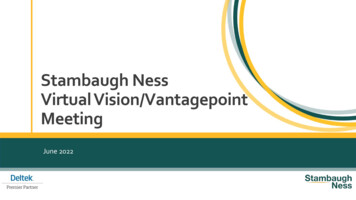
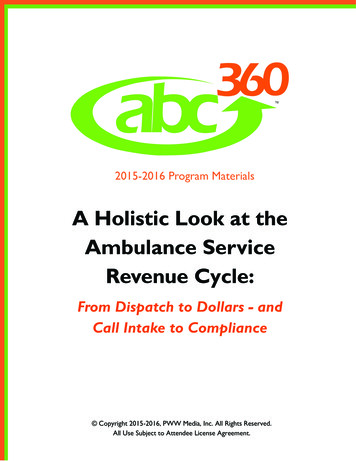
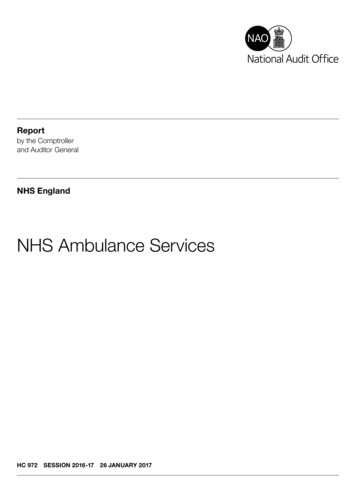
![MOH STANDARDS FOR EMERGENCY AMBULANCE SERVICE (2017) [Updated 21 Nov 2018]](/img/51/emergencyambulancestandards.jpg)

